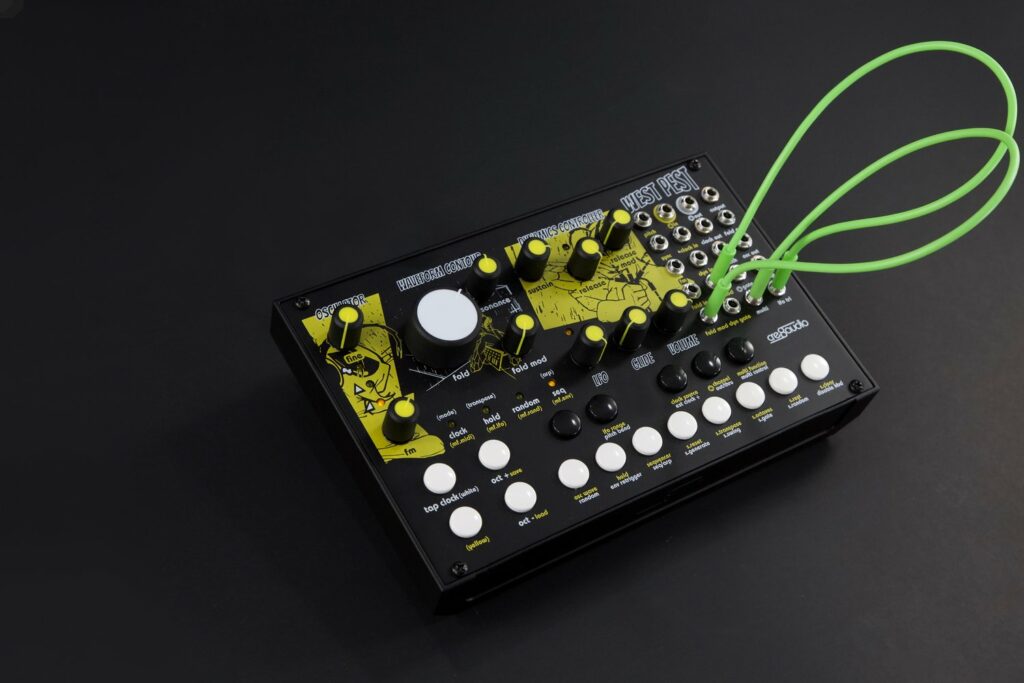Buchla on a budget? Kind of. Cre8audio’s new synth module proves to be a bit of a bargain if you’re looking for a West Coast synth which won’t break the bank. Greg Scarth finds out.

We were hugely impressed by the Cre8audio East Beast when we recently reviewed it, loving its straightforward approach to semi-modular synthesis, packaged into an affordable, Eurorack-compatible instruments. The West Best is its slightly more quirky counterpart, based on a similar concept but with a more quirky approach. The main benefits of the Cre8audio West Pest are very much the same as the East Beast: it’s a fun, intuitive synth which offers surprising depth at a very competitive price. What’s different is the way it goes about generating sound, and the character it exhibits as a result. The vast majority of analogue synths work via subtractive synthesis – sometimes known as East Coast synthesis – closely associated with classic brands like Moog, but the West Pest follow a different philosophy.
The West Pest’s approach is based around classic West Coast principles closely associated with synth pioneers like Don Buchla and Serge Tcherepnin. Rather than using subtractive synthesis, West Coast synths typically used additive techniques like frequency modulation and wavefolding to create distinctive tones. The key reference point here is the iconic Buchla Easel, an all-in-one instrument which has become legendary for its organic, evocative sound and its inspiring hands-on controls. The downside is that the Easel doesn’t come cheap, with the current Easel Command model bearing a price tag not too far off £3,000. The West Pest is a far more humble instrument in every aspect, not least in the sense that it costs just over £200, but it combines a few of the key features which define the sound and useability of the Buchla.

Using the West Pest isn’t complicated whether you’re a complete beginner or experienced with East Coast synthesis, but it does require a slightly different mindset to subtractive synthesis. It’s easiest to break it down into sections and explore what benefits this unusual approach to synthesis has to offer. Firstly, the oscillator section is incredibly simple compared to most synths: there’s a choice of sine, triangle and saw waves, plus the option to employ frequency modulation via the LFO or a CV input. It’s a lot more simple than you’d expect on a typical subtractive synth, with just one VCO, no square wave (they’re too harmonically rich for what comes next), no PWM, no sync and no ring mod. The oscillator core feeds into the Waveform Contour section, which is where we see proper additive synthesis enter the equation. Rather than removing harmonics using a filter, West Coast synthesis adds harmonics at this stage. Twisting the Timbre control folds the wave back on itself, giving a range of different tones from soft, subtle warmth through to quite dramatic fuzz.

The next aspect which sets the West Pest apart from most synths is the use of a Dynamics Controller section rather than the more conventional envelope generator to shape the sound. Cre8’s approach to dynamics is inspired by the classic Buchla low-pass gate, which effectively controlled the level and harmonics of the sound in unison, creating a subtlety and organic feel which is a distinctive part of the Buchla sound. The circuit in the West Pest is a bit different to a classic low-pass gate, offering more control of the response time thanks to . The resonance control next to the Timbre knob comes into play here too; it’s actually part of the Dynamics Controller section despite the placement of the knob, adding resonance to the dynamics stage. Combining the wavefolder section and dynamics section, you really begin to see the appeal of the West Coast approach. In terms of philosophy and application it’s very different to most analogue synths, but it produces sounds which you’d struggle to achieve using subtractive synthesis: lush, evolving drones, organic blips and bleeps, evocative tones.

Like so many of the all-time great synths, the West Pest is deceptively simple. There are hidden depths here which offer far more than you might first expect from a synth with just 11 knobs on the front panel. Most of the features are identical to those we enjoyed on the East Beast – a handy built-in arpeggiator/sequencer, MIDI control via TRS adaptors, deeper sound options via shift keys and secondary functions – but it’s the patchability of the West Pest which is its real strength. Cre8audio say that the West Pest is the equivalent of having eight separate modules in one, and the ability to reroute the signal and CV modulation using patch cables opens up a vast array of deeper options, from sequencing the timbre of your sounds through to modulating dynamics. If you have other patchable gear – whether semi-modular synths or a full Eurorack setup – then you’ve got even more options. The West Pest is a particularly appealing way to add some West Coast approaches to an existing modular system.

It’s worth stressing that the West Pest isn’t trying to be a feature-for-feature clone of any Buchla synth. There’s an argument that the Korg Volca Modular is a more faithful Buchla-inspired compact synth, but there are more than enough advantages to the West Pest to make it an appealing option – better hands-on controls, MIDI support, Eurorack compatibility. It’s a synth with true character and one which inspires creativity. Sync it to a drum machine, plug it into a nice reverb and you’ve got a single box which you can make some killer ambient techno with; hook it up as part of a bigger setup and you can add unique West Coast tones to your tonal palette. At just over £200, it’s a bargain entry point to the wonderful world of West Coast synthesis.
More info/buy